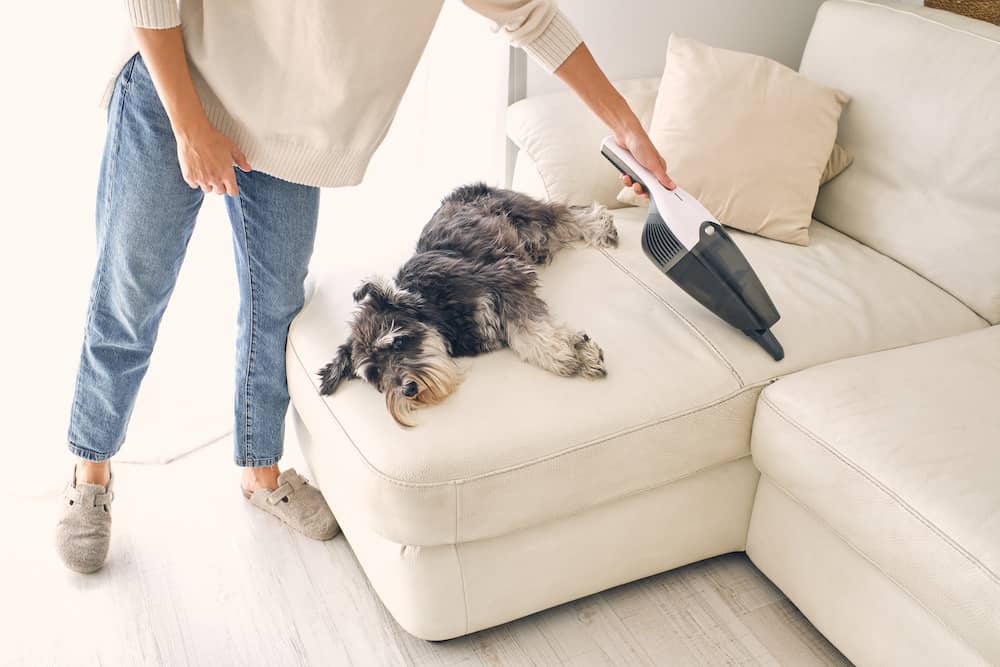Key Takeaways:
- Allowing dogs on furniture can lead to behavioral issues, as they may become territorial and possessive of the furniture.
- Dogs that are allowed on furniture may have a harder time understanding boundaries and respecting personal space.
- Keeping dogs off furniture can help prevent them from bringing dirt, allergens, and parasites onto the furniture.
- Allowing dogs on furniture can make it more difficult to keep the furniture clean and free from fur, stains, and odors.
- Regularly providing comfortable dog beds or designated areas for dogs to relax can offer a suitable alternative to allowing them on furniture.
Are you a dog lover? Do you find yourself constantly torn between wanting to cuddle up with your furry friend on the couch and worrying about the mess they may leave behind? If so, you're not alone. The debate over whether dogs should be allowed on furniture is a topic that has sparked passionate discussions among pet owners and animal enthusiasts alike. But why should we even bother delving into this subject? Well, understanding the pros and cons of allowing dogs on furniture can help us create a harmonious living environment for both humans and our four-legged companions. By exploring this topic, we can uncover valuable insights that may surprise you and ultimately lead to a happier coexistence between man and dog. So let's dive in and discover whether or not Fido should have a spot on the sofa!
Should Dogs Be Allowed on Furniture?
Benefits of Allowing Dogs on Furniture
Allowing dogs on furniture can have several benefits for both the dog and the owner. One benefit is that it can strengthen the bond between the dog and the owner. When a dog is allowed on furniture, it can feel like a special privilege and can make them feel closer to their owner. This closeness can lead to increased feelings of trust and companionship.
Another benefit is that allowing dogs on furniture can provide them with a comfortable place to rest. Dogs are social animals and often enjoy being near their owners. Allowing them on furniture gives them a cozy spot where they can relax while still being close to their family.
Health and Hygiene Concerns with Dogs on Furniture
While there are benefits to allowing dogs on furniture, there are also some health and hygiene concerns to consider. Dogs can carry dirt, bacteria, and allergens into the house from outside. If they are allowed on furniture, these contaminants can be transferred onto upholstery, cushions, and bedding.
In addition, dogs may shed fur or leave behind drool or urine stains when they are on furniture. This can create a mess that requires regular cleaning and maintenance. It's important to regularly clean and vacuum furniture that dogs have access to in order to maintain cleanliness and prevent any potential health issues.
How Does Allowing Dogs on Furniture Affect Their Behavior?
Allowing dogs on furniture can have an impact on their behavior. Some dogs may become possessive of their spot on the furniture and show aggression if someone tries to take it away from them. This possessiveness can extend beyond just the furniture and affect their behavior in other areas as well.
In some cases, allowing dogs on furniture can also lead to an increase in separation anxiety. If a dog becomes accustomed to being on furniture and then is suddenly not allowed, they may become stressed and anxious when left alone. It's important to consider the potential behavior changes before deciding whether or not to allow dogs on furniture.
Alternatives to Allowing Dogs on Furniture
If you prefer not to allow your dog on furniture, there are alternatives that can still provide them with a comfortable place to rest. Providing your dog with their own bed or mat can give them a designated spot where they can relax. You can make this area cozy by adding blankets or pillows that are specifically for your dog.
Another alternative is to create a designated space for your dog using pet gates or crates. This way, they have their own area where they can feel safe and secure without being on the furniture. It's important to make sure this space is comfortable and inviting for your dog so that they are more likely to use it.
Cultural Differences in Allowing Dogs on Furniture
The decision of whether or not to allow dogs on furniture can vary depending on cultural norms and personal preferences. In some cultures, allowing dogs on furniture is seen as normal and even encouraged as a way of showing affection towards pets. In other cultures, it may be considered unhygienic or disrespectful to allow dogs on furniture.
It's important to respect cultural differences and personal preferences when it comes to allowing dogs on furniture. If you are unsure about what is acceptable in your culture or community, it may be helpful to seek advice from local pet owners or consult with a veterinarian.
Training Strategies to Keep Dogs Off Furniture
- Consistency: Establish clear rules about whether or not dogs are allowed on furniture and consistently enforce them. Dogs thrive on routine and will learn more quickly if they receive consistent messages.
- Provide alternatives: Make sure your dog has their own comfortable bed or designated space where they can rest. Encourage them to use this area by providing treats or rewards when they choose to use it instead of the furniture.
- Positive reinforcement: Reward your dog with praise, treats, or playtime when they choose not to get on the furniture. This will reinforce the desired behavior and make them more likely to repeat it in the future.
- Use deterrents: Place aluminum foil, double-sided tape, or a pet-safe deterrent spray on the furniture to make it less appealing for your dog. Dogs generally dislike these textures and smells and may be less inclined to jump on the furniture if they encounter them.
Benefits of Allowing Dogs on Furniture
Enhanced Bonding and Comfort
Allowing dogs on furniture can strengthen the bond between humans and their furry companions. When dogs are allowed to snuggle up on the couch or bed, it creates a sense of closeness and intimacy. This physical contact can promote feelings of security and comfort for both the dog and their owner. Additionally, sharing furniture with dogs can provide them with a sense of belonging within the family unit.
Reduced Anxiety and Stress
Research has shown that allowing dogs on furniture can help reduce anxiety and stress levels in both humans and dogs. The act of cuddling or being close to their owners releases oxytocin, also known as the "love hormone," which promotes relaxation and reduces stress. For individuals dealing with mental health issues or high-stress lifestyles, having their furry friend by their side on the couch can provide much-needed emotional support.
Tips for Allowing Dogs on Furniture:
- Place a washable cover or blanket on furniture to protect it from fur, dirt, and potential accidents.
- Regularly groom your dog to minimize shedding.
- Train your dog to ask for permission before jumping onto furniture.
Health and Hygiene Concerns with Dogs on Furniture
Potential Allergies and Asthma Triggers
Allowing dogs on furniture may pose health risks for individuals with allergies or asthma. Dog dander, saliva, urine, or hair left behind on furniture can trigger allergic reactions or worsen existing respiratory conditions. It is important to consider these factors before deciding whether to allow dogs on furniture in households where such health concerns exist.
Maintaining Cleanliness
Dogs naturally carry dirt, bacteria, and parasites into our living spaces. Allowing them on furniture can increase the difficulty of keeping furniture clean and hygienic. Regular vacuuming, washing of covers or blankets, and professional upholstery cleaning may be necessary to minimize the accumulation of allergens, odors, and potential health hazards.
Tips for Maintaining Cleanliness:
- Establish a regular grooming routine to minimize shedding and dirt accumulation.
- Use pet-friendly cleaning products to sanitize furniture surfaces.
- Consider providing dogs with their own designated furniture or beds to reduce contact with human furniture.
How Does Allowing Dogs on Furniture Affect Their Behavior?
Allowing dogs on furniture can have both positive and negative effects on their behavior.
On one hand, it can reinforce a dog's sense of hierarchy within the family. When a dog is allowed on furniture, they may perceive themselves as equal or higher in rank than their owners. This can lead to dominant behaviors such as resource guarding or territorial aggression.
On the other hand, allowing dogs on furniture can also provide them with a sense of security and comfort. It can help alleviate separation anxiety when owners are away from home and promote relaxation during stressful situations.
Alternatives to Allowing Dogs on Furniture
If you prefer not to allow your dog on furniture, there are alternative options that still provide comfort and security for your furry friend.
Investing in comfortable dog beds or mats specifically designed for dogs can offer them a cozy spot of their own. Placing these beds in areas where you spend time together, such as the living room or bedroom, allows your dog to be close without being directly on the furniture.
Additionally, creating designated "dog zones" within your home can give your pet a sense of ownership over certain spaces. These zones can be equipped with toys, blankets, and treats to make them enticing for your dog while keeping them off human furniture.
Cultural Differences in Allowing Dogs on Furniture
The acceptance of dogs on furniture varies across different cultures. In some cultures, dogs are considered part of the family and are allowed full access to furniture without any hesitation. This is often seen in Western countries where pets are commonly treated as companions and even regarded as "fur babies."
However, in other cultures, allowing dogs on furniture is frowned upon or strictly prohibited. This can be influenced by cultural beliefs, religious practices, or hygiene standards. It's important to respect and understand these cultural differences when interacting with individuals from diverse backgrounds.
Training Strategies to Keep Dogs Off Furniture
Positive Reinforcement
Using positive reinforcement techniques can effectively train dogs to stay off furniture. Rewarding your dog with treats, praise, or playtime when they choose to stay off the furniture encourages them to repeat this behavior. Consistency is key in reinforcing the desired behavior and redirecting them to their designated spots.
Provide Attractive Alternatives
Offering appealing alternatives such as comfortable dog beds or mats can entice your dog away from the furniture. Make sure these alternatives are placed in desirable locations and provide a cozy environment for your pet.
Tips for Training Strategies:
- Use verbal cues like "off" or "bed" consistently when training your dog.
- Redirect their attention to their designated spot whenever they attempt to jump onto furniture.
- Be patient and consistent with training efforts, as it may take time for your dog to learn and adapt.
By considering the benefits, health concerns, behavioral effects, alternatives, cultural differences, and training strategies related to allowing dogs on furniture, you can make an informed decision that suits both you and your furry friend's needs. Remember that every dog is unique, so finding the right balance between comfort and boundaries will ensure a harmonious living environment for all.
In conclusion, whether or not dogs should be allowed on furniture depends on the individual's preferences and household rules. It is important to consider factors such as cleanliness, comfort, and training before making a decision.
Should dogs not be allowed on furniture?
If your dog is well-behaved and doesn't have any behavior issues, and you are satisfied with their level of obedience training, then there is no reason why you shouldn't let them on your furniture.
Why not to allow dogs on couch?
Even if your dog doesn't exhibit aggression or territorial behavior towards the couch, it can still cause problems in the future. If you have friends over for a movie night, there's a high likelihood that your dog will expect its usual spot on the couch and may invade your guests' personal space without hesitation.
Why dogs should be allowed on furniture?
In most cases, allowing your dog to be on the furniture is unlikely to result in any issues, whether it be behavioral or otherwise. Dogs enjoy snuggling on the couch, bed, or any other comfortable spot. They also enjoy spending time in the same places as their owners.
What percentage of people let dogs on furniture?
Based on a survey by the American Kennel Club (AKC), 80% of dog owners permit their dogs to be on furniture or even share their bed. The survey also found that 44% of pet owners allow their pets to sleep in bed with them.
Is it bad to allow dog on bed?
Main idea: Sleeping with dogs can increase the risk of human exposure to parasites and vector-borne diseases, especially for vulnerable individuals such as the very young, very old, and immune compromised. Dogs carry intestinal parasites, fleas, and ticks that can cause illnesses in humans.
What should you never do with dogs?
It is important to avoid forcefully pulling on your dog's leash or using a choke collar for discipline. According to Szydlowski, a veterinarian, dogs have a hyoid bone near the back of their tongue that can be fractured if the leash is yanked. This can lead to various health issues. Similarly, using a choke collar, which tightens when the dog pulls away, is also unsafe.

















